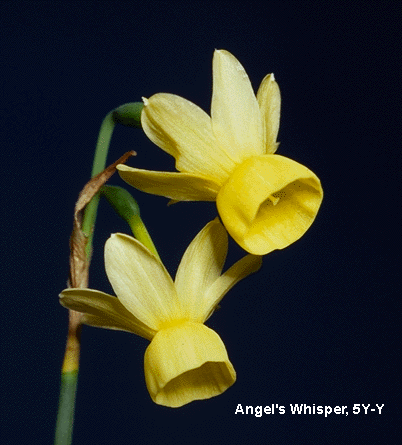
1. The classification of a daffodil cultivar (cultivated variety) is based on the description and measurements or the classification submitted by the person registering the variety.
Color codes used to describe the color of daffodils are as follows:
- W – White or Whitish
- G -Green
- Y – Yellow
- P – Pink
- O – Orange
- R – Red
3. For the purpose of the description, the daffodil is divided into two regions, the perianth (petals) and corona (cup).
4. The perianth (petals) is described using letters of the color code most appropriate, identifying first the outside edge of the petal, then the middle, and lastly the inside part next to the corona.
5. The corona (cup) is described using letters of the color code most appropriate, beginning with the inside, eye-zone, then the mid-zone and extending out to the edge or rim.
6. The written format used to describe the classification of a daffodil is the following:
- division designation (number 1-13),
- letter or letters of the color code most accurately describing the zones of the perianth followed by a hyphen,
- letter of the color code, most accurately describing the zones of the corona
For example, Angel’s Whisper in the photo above is a Division 5 with Yellow Petals and-a Yellow Cup so is coded as: 5 Y-Y
7. In Division 4, double daffodils, the letters of the color code accurately describing the mixture of petals and petaloids follow in proper order, using three, two, or one color codes as appropriate.
8. If the perianth and/or corona are substantially of a single color; a single letter of the color code is used to describe its classification.
Whether of wild or cultivated origin, once a selection has been distinguished by a cultivar name it is normally assigned to Divisions 1-12. Daffodils distinguished solely by botanical name should be assigned to Division 13.
Notes
The characteristics for Divisions 5 to 10 are given for guidance only; they are not all necessarily expected to be present in every cultivar assigned to those divisions.
All Daffodils are classified into one of the thirteen divisions described below:
Division 1 – Trumpet
One flower to a stem, corona (trumpet or cup) as long or longer than the
perianth segments (petals).
Division 2 – Long Cup
One flower to a stem, corona (cup) more than one third but less than
equal to the length of the perianth segments (petals).
Division 3 – Short Cup
One flower to a stem, corona (cup) not more than one third the height
of the perianth segments (petals).
Division 4 – Double
Daffodils have a clustered cup, petals or both. There can be one or more flowers per stem.
Division 5 – Triandrus
Usually more than one flower to a stem, head drooping, perianth
segments often reflexed and of silky texture.
Division 6 – Cyclamineus
One flower to a stem, perianth usually reflexed and corona straight and
narrow. Some exceptions exist.
Division 7 – Jonquilla
Usually several flower heads to a stem, flowers usually fragrant, stem is
round in cross-section and foliage is often rush like.
Division 8 – Tazetta
Usually three to twenty flowers to a stout stem, sweet scented and very short cupped. Perianth segments rounded and often somewhat crinkled. Very Fragrant.
Division 9 – Poeticus
Usually one flower to a stem. White petals sometimes stained with the
corona color at the base, small flat cup edged with red. Fragrant.
Division 10 – Bulbocodium Hybrids
Small flowers resemble a “hoop petticoat” form.
Division 11 – Split Corona
Corona split for at least one third of its length.
![]() a) Collar Daffodils
a) Collar Daffodils ![]() Split-corona daffodils with the corona segments opposite the perianth segments; the corona segments usually in two whorls of three
Split-corona daffodils with the corona segments opposite the perianth segments; the corona segments usually in two whorls of three
![]() b) Papillon Daffodils
b) Papillon Daffodils ![]() Split-corona daffodils with the corona segments alternate to the perianth segments; the corona segments usually in a single whorl of six
Split-corona daffodils with the corona segments alternate to the perianth segments; the corona segments usually in a single whorl of six
Division 12 – Other Cultivars
Daffodils not falling into any of the previous categories.
Division 13 – Species
All species and reputedly wild forms. Doubles of these varieties are included.
For beautiful color photographic examples of each Division, see Daffodil Varieties